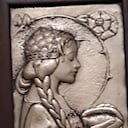If a doctor gave you a Ishihara test, what would they be testing for?
The Ishihara test is a color perception test for red-green color deficiencies, the first in a class of successful color vision tests called pseudo-isochromatic plates ("PIP"). It was named after its designer, Shinobu Ishihara, a professor at the University of Tokyo, who first published his tests in 1917.
The test consists of a number of colored plates, called Ishihara plates, each of which contains a circle of dots appearing randomized in color and size. Within the pattern are dots which form a number or shape clearly visible to those with normal color vision, and invisible, or difficult to see, to those with a red-green color vision defect. Other plates are intentionally designed to reveal numbers only to those with a red-green color vision deficiency, and be invisible to those with normal red-green color vision. The full test consists of 38 plates, but the existence of a severe deficiency is usually apparent after only a few plates. There are also Ishihara tests consisting of 10, 14 or 24 test plates.
More Info:
en.wikipedia.org









